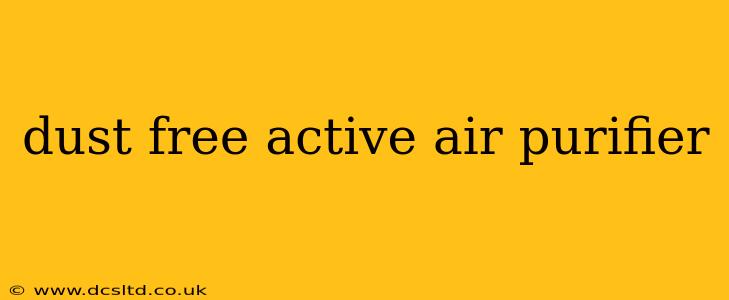Are you tired of battling dust and allergens in your home? Do you dream of breathing clean, fresh air, free from irritants? Then you're in the right place! This comprehensive guide will explore the world of active air purifiers, focusing specifically on those designed to combat dust and improve indoor air quality. We’ll delve into how they work, what to look for when choosing one, and answer some frequently asked questions to help you find the perfect dust-free solution for your needs.
What is an Active Air Purifier?
Unlike passive methods like air filters, active air purifiers actively work to remove pollutants from the air. They use a combination of technologies to capture, neutralize, or destroy airborne particles, including dust, pollen, pet dander, mold spores, and other allergens. Many incorporate HEPA filters, which are highly effective at trapping microscopic particles, contributing significantly to a dust-free environment.
How Do Active Air Purifiers Remove Dust?
Active air purifiers utilize several methods to remove dust and other pollutants:
-
HEPA Filtration: High-Efficiency Particulate Air (HEPA) filters are the cornerstone of many effective air purifiers. These filters trap at least 99.97% of particles 0.3 microns in size and larger. This includes the majority of dust particles, pollen, and other airborne allergens.
-
Activated Carbon Filters: These filters absorb gases and odors, further enhancing air quality. While not directly removing dust, they contribute to a fresher, cleaner smelling environment, complementing the work of the HEPA filter.
-
UV-C Light: Some advanced models incorporate UV-C light, which kills bacteria and viruses in the air. While not directly removing dust, UV-C light sterilization contributes to a healthier indoor environment overall.
-
Electrostatic Precipitators: These filters charge dust particles, causing them to stick to a collector plate, increasing the efficiency of dust removal.
What Size Air Purifier Do I Need?
Choosing the right size air purifier is crucial for effective dust removal. Consider the following factors:
-
Room Size: The purifier's coverage area (usually specified by the manufacturer) should be appropriate for the room's square footage. A larger room requires a more powerful purifier.
-
Ceiling Height: Higher ceilings mean the purifier needs to circulate air more effectively.
-
Number of Occupants and Pets: More people and pets generate more dust and allergens, requiring a more powerful unit.
Which Features Should I Look For in a Dust-Free Air Purifier?
When selecting a dust-free air purifier, consider these key features:
-
HEPA Filter Rating: Look for purifiers with true HEPA filters, ensuring high-efficiency particulate removal.
-
CADR Rating: Clean Air Delivery Rate (CADR) indicates the volume of clean air delivered per unit of time. Higher CADR values mean faster cleaning.
-
Noise Level: Consider the noise level, especially if you plan to use the purifier in a bedroom or quiet area.
-
Filter Replacement Indicators: These indicators will alert you when it's time to change the filters, maintaining optimal performance.
-
Smart Features: Some models offer smart features like app control, scheduling, and air quality monitoring.
What are the benefits of using a dust-free active air purifier?
-
Improved Respiratory Health: By reducing dust and allergens, air purifiers can alleviate allergy symptoms such as sneezing, coughing, and itchy eyes.
-
Better Sleep Quality: Cleaner air can contribute to better sleep, especially for those with allergies or asthma.
-
Reduced Risk of Infection: Removing airborne pathogens helps to reduce the risk of respiratory infections.
-
Protection of Electronics and Furniture: Dust can damage electronic components and accumulate on furniture. Air purifiers help mitigate this issue.
How often should I replace the filters in my active air purifier?
Filter replacement frequency depends on the air purifier model, usage intensity, and air quality. Manufacturers typically provide guidelines, but it's generally recommended to replace filters every 6-12 months. Always check the manufacturer's recommendations for your specific model.
Are there any downsides to using active air purifiers?
While generally beneficial, active air purifiers have some drawbacks:
-
Cost: The initial purchase price and ongoing filter replacement costs can be significant.
-
Energy Consumption: Air purifiers consume electricity, adding to your energy bill.
-
Maintenance: Regular filter replacement and cleaning are necessary to maintain optimal performance.
Conclusion
Investing in a high-quality active air purifier can significantly improve your indoor air quality and contribute to a healthier, dust-free home environment. By carefully considering your needs and researching different models, you can find the perfect solution to breathe easier and enjoy cleaner, healthier air. Remember to always consult the manufacturer's instructions for optimal use and maintenance of your chosen air purifier.
